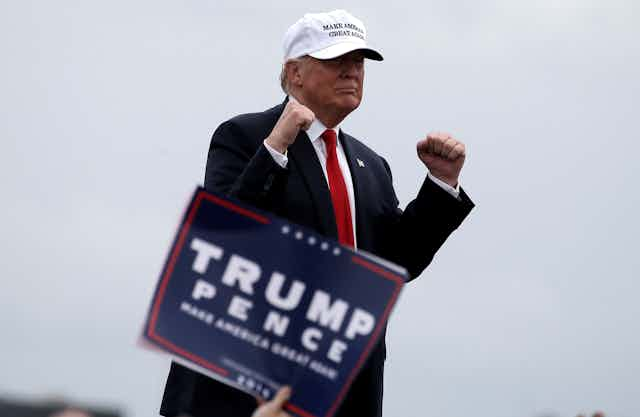We are fast approaching what is perhaps the most fascinating US presidential election in recent memory.
Our interpretations of the election might proceed along two quite different tracks.
First, we might focus on its functions in the American democratic system. Its winner can claim to represent “the American people” in a way that nobody else can. And their victory will be an important barometer of political forces and public opinion.
Alternatively, we might focus on the mechanics of the election process — or how the winner was “generated.”
Under the spotlight would be the quirks of the Electoral College, the fairness of media coverage and campaign financing, and the ups and downs of the candidates’ campaigns.
When it comes to the election, both perspectives carry important truths. The winner — likely to be Hillary Clinton, despite her recent troubles — will probably be more representative of the state of the nation at this point in time.
How did we get to this point? How is it that Clinton is vying with Donald Trump for arguably the most powerful job in the world?
To answer this, we should look at the quirkiness of the nomination process, and why Republican voters chose Trump over other, more traditional GOP candidates.
Trump’s rise has been interpreted as a sign of important trends in the Republican Party and America more generally. In particular, his rise has been explained as a reaction to economic stagnation and evidence of growing insecurity about multiculturalism and immigration.
Given the eccentricities of the nomination processes, these are risky interpretations.
Below I present a brief (and somewhat crude) test of the idea that Trump’s rise represents a “phenomenon” of some kind, rather than a quirky victory.
The geography of Trump’s rise
Trump ended up winning the Republican nomination by a comfortable margin. But the size of his victories (and depth of his occasional defeats) varied across the states.
The figure below presents data on the size of Trump’s victories in the primaries. The redder the red, the bigger the Trump win; the deeper the blue, the larger the Trump defeat.
For example, Trump won big in New Jersey and West Virginia. But he suffered big defeats in DC and Wyoming.
If Trump’s rise represents a phenomenon of some kind, we might expect a tight relationship between the size of Trump’s victory (or defeat) in a state and the characteristics of that state.
So, if Trump’s rise was due to economic stagnation, we might expect slow-growth states to provide his biggest victories.
If Trump’s rise was due to traditionalists feeling threatened by multiculturalism, we might expect states with large white populations to provide the biggest Trump victories.
If Trump’s rise was due to the threat of immigration from Mexico, we might expect states that border Mexico to provide the biggest Trump victories.
Is this what we observe? The short answer is “not really”.
An economic phenomenon?
The table below presents data on the economic performance of the states since Obama became president (2009-15).
Overlaying this data is the colour coding of the previous table, indicating the size of Trump victories and defeats.
As this comparison suggests, Trump won big in some fast-growing states, but also in some slow-growing states.
More generally, there isn’t a strong correlation between the size of Trump’s victory and the economic performance of a state.
A sociological phenomenon?
The table below presents demographic data, indicating the proportion of the population that identifies as “white.”
Once again, I’ve overlaid the colour coding of Trump victories and defeats. Here too, his rise is not well explained by the size of the white population.
Finally, did Trump’s biggest victories come in the states that border Mexico (Arizona, California, New Mexico and Texas)? Trump did win comfortably in California and New Mexico, but not in Arizona or Texas – he lost both.
The power of good timing
In short, there are reasons to doubt “big” explanations of Trump’s rise, which argue it is indicative of a broader political movement.
As an alternative, we might focus on how Trump succeeded in a quirky process. The most important feature of the process is “momentum” – once a candidate starts winning, s/he becomes very difficult to stop.
So if you can win in a few early primaries – for whatever reason – you can sweep the nation.
The table below presents the primaries in their calendar sequence. As this table suggests, Trump’s performance in a state was closely related to when that state held its primary.
His early victories were marginal, but crucial because they got his campaign rolling.
His late victories were the really big ones. By this stage Trump had too much momentum to stop (as the Republican party establishment discovered). And this gave him an unrivalled platform in the media to make policy pronouncements.
If, as this table suggests, Trump’s rise was fuelled mainly by his momentum, this suggests the importance of not over-interpreting what his nomination as Republican candidate means.
He won largely by succeeding in tightly-fought races early on.
The margins were close, and Trump’s successes in these primaries were due at least as much to his rivals’ mistakes and underestimations of his candidacy as they were to any groundswell of support in his favour.
Even if Trump loses the election, he will still win the votes of many millions of Americans (because they face what is effectively a two-horse race). We shouldn’t assume that his views are a good reflection of theirs.

